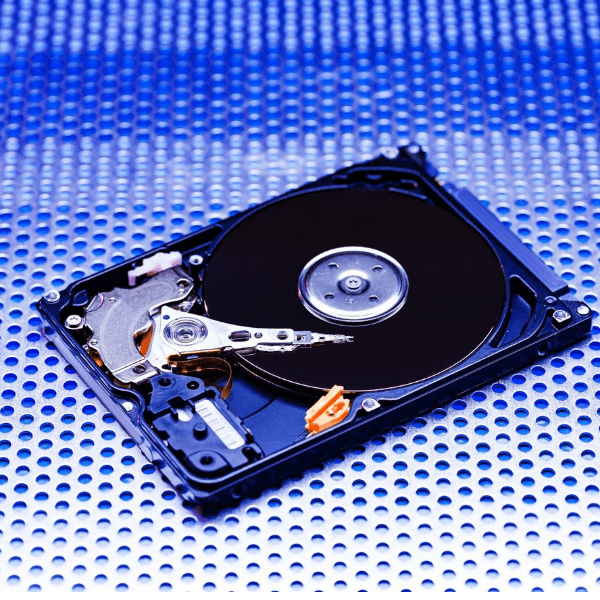As statistics show, most hard disks, such as Seagate and Western Digital, have a maximum temperature limit of around 60°C, and the electrical components start to degrade from this point.
The ideal ambient temperature for a hard disk is assumed to be between 25°C and 40°C. A temperature of anywhere between 41°C and 50°C is still considered acceptable.
If your disk overheats, pay attention to some other signs that may indicate that your hard disk is about to fail:
- The computer’s fan makes a loud noise;
- Files cannot be opened, they are corrupted;
- High disk usage (100%);
- The hard disk is too slow to access or open files;
- The computer/laptop suddenly shuts down, displaying a completely blue screen;
- Bad sector error messages appear constantly when trying to open the drive;
- The hard disk makes unusual noises, mainly an occasional click or hum.
In other words, if your PC shows these signs – in addition to overheating – it indicates that there may be an imminent disk failure, which could cause the hard disk not to boot, making your data inaccessible.
In this article, you’ll find out what can cause your disk to overheat, what it entails, how to repair your hard disk, what the recovery steps are and how to prevent this problem from happening again.

What can make a disk too hot?
- Blocked airflow – air needs to be able to flow into the computer so that the coolers can do their job. Make sure the computer is located where nothing blocks the air from reaching the vents;
- Defective cooler – when cooler gets dirty, has to work harder to maintain the ideal temperature and causes the hard disk to overheat. Therefore, clean this component every 3-6 months;
- Dust – not only does it block the flow of air, but it also isolates the components that need to be cooled by the coolers. Dust is your enemy, so put your computer in a place that is easy to keep clean and free of dust.
What are the results of the disk overheating?
When any device is forced to operate in a hot environment, its performance suffers.
When disks overheat, the effects are slow read/write speeds, an operating interface that constantly crashes or even shuts down on its own.
In addition, these environments can also result in a damaged disk. In some cases, the damage is so severe that the drive cannot read the data it contains.
Heat also causes electrical components to degrade and potentially fail.
All the data stored on a disk is recorded on metal disks called platters which, when they expand and contract due to heat, can damage other components, as well as gradually becoming damaged surfaces.
Even if the damage is minimal, this is enough to prevent your data from being read/written.
There are several parts of a disk that can fail due to overexposure to heat, including the part that actually stores the data.
The individual pieces of data that make up a file – called bytes – are stored in separate locations.
When you save a file, the location of each individual byte is recorded by its drive.
When you open that file, these individual locations are displayed, the bytes are read and the file is reconstituted and displayed.
These bytes are stored in microscopic sectors, so if there is damage to the disk platter – even minimal – your files cannot be read.
How to repair an overheated computer/laptop disk
When a hard disk is temporarily overheated, you can stop writing or reading data for a while to wait for the hard disk to cool down and avoid causing further damage or data loss.
But if you have already lost data due to a disk overheating problem, you have 2 options to get your lost files back before the hard disk is physically damaged:
- Use data recovery software
- Send your disk to a company specializing in file recovery, such as Bot.
Steps for recovering an overheated hard disk
To stop your disk from overheating, you can resort to different methods – the main ones being: closing the programs that consume the most CPU resources, scanning and removing viruses, cleaning dust and fixing bad sectors.
Here’s how to proceed with each of these methods:
Method 1: Close programs you don’t need to use
Reduce as much as possible the number of applications that consume high CPU and disk memory resources.
To identify these programs and close them, press Ctrl + Alt + Del simultaneously to open the Windows Task Manager.
Go to the “Processes” tab, select the programs that take up the most CPU resources and click on “End Process”.
Method 2: scan and remove viruses
Sometimes the task manager shows 100% disk usage, but finds nothing consuming the CPU.
In this case, be careful: the real cause could be a computer virus, which drains your CPU’s memory.
To eliminate viruses, you can use an antivirus or follow the step-by-step instructions below:
- Step 1: type “Command Prompt” in the search box and click on it to open it. Log in with your administrator account and password – if the system prompts you to do so
- Step 2: type the letter of your drive, followed by a colon and press Enter. For example, if the letter of your disk drive is F, type F: and press Enter.
- Step 3: type del * .lnk and press Enter
- Step 4: type atrib -s -r -h *. * / S / d / l and press Enter.
If this does not work, your PC/laptop is probably infected with another type of virus. Replace .lnk with another virus extension such as *.exe to delete these suspicious files.
Method 3: keep it clean
The longer you use the machine in a fixed location, the more dust and debris will accumulate and block the passage of air, causing the disk to overheat.
For simple cleaning, you can use a small piece of cotton cloth and a little isopropyl alcohol. A cotton swab is also a good option for internal areas.
If you prefer a thorough cleaning, you can send it to a professional repair center.
Method 4: Fix bad sectors on your hard disk
Having too many bad sectors largely causes the hard disk to malfunction, making it difficult for the computer to load files and causing the disk to overheat.
You can check for bad sectors using chkdsk commands:
- Press the key with the Windows symbol + X and click on the “Command Prompt” option
- Right-click on Command Prompt and select “Run as administrator”
- In the Command Prompt window, type chkdsk f: / f / r and press Enter. Remember to replace the “f” with the letter of your hard disk drive.
How to avoid hard disk overheating problems?
If you want to prevent your disk from overheating again, you need to take preventive measures such as:
- Be careful where you keep your computer and external hard drives: never store them in areas that are above the ideal temperature for long periods, such as in the car or in direct sunlight.
- Don’t use your laptop on your lap or directly on the bed: this blocks the air flow, putting your hard disk in danger. If you often use your laptop in this way, consider buying a cooling base that sits underneath it to keep it at the ideal temperature.
- Clean your computer regularly: ventilation areas can easily become blocked over time. Cleaning the dust off your devices will have a big impact on their lifespan.
Conclusion
The ideal disk temperature should be between 25°C and 40°C, and the hard disk can degrade from a temperature of 60°C.
If your disk overheats, this could be due to blocked airflow, a faulty cooler or a build-up of dust.
The effects of an overheated disk are: failure to read/open files, sudden shutdown of the PC/laptop and even loss of your data.
Some of the methods for recovering the disk when it is overheating are: closing unnecessary programs that take up a lot of CPU resources, scanning and removing viruses (which may be overloading the disk’s capacity), cleaning up accumulated dust and correcting bad sectors on the hard disk.
If your disk has overheated and, as a result, you have lost your data, it is best to turn to a specialized service – such as Bot – to get it back.
We can recover your data while guaranteeing the integrity of your disk, as we operate in a Clean Room: a closed environment that allows total control of the concentration of airborne particles, preventing any impurities from entering your disk.
Even better: We collect your device free of charge from any address in Portugal and send you a free quote within 48 hours.
Trust those with over 11 years’ experience in data recovery: start your recovery at Bot and become one of our more than 100,000 solved cases!


